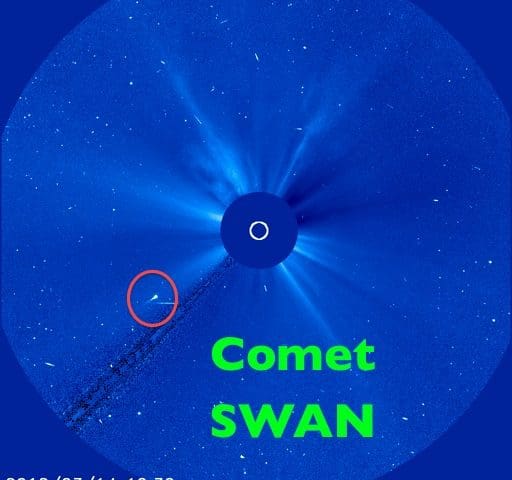
Sungrazing comet seen for the first time with the SOHO/SWAN instrument. It is aptly named Comet SWAN.

Ukrainian Amateur astronomer, citizen scientist, and SOHO Comet Hunter Vladimir Bezugly reported a bright blob on images taken by the SWAN instrument on SOHO. This turned out to be a type of sungrazing comet called a Kreutz Comet from the same family as the famous Sun surviving Comet Lovejoy. Named after a 19th century German astronomer who studied them in detail, Kreutz sungrazers are fragments from the breakup of a giant comet at least 2000 years ago. Several of these fragments are thought to pass by the sun and disintegrate every day. Most are too small to see, but occasionally a big fragment like this one attracts attention. There have been 2200+ of these type of comets discovered, thanks largely to SOHO, so this would seem like no big deal. But it is because one of these has never been seen before with SWAN.

SWAN is an “all-sky” imager meaning it has a 360-degree view. It cannot look at the Sun or the Earth so those are the blacked out parts in the SWAN image. SWAN is not a traditional imager/camera. It “sees” a type of ultraviolet light called Lyman-alpha. It was designed to measure this light coming from solar wind particles interacting with solar light. But we can also see this type of light coming from comets. Solar UV radiation splits up water molecules and the liberated hydrogen atoms glow in UV light. So observing the comet in SWAN means that there is a large amount of hydrogen (water) in the comet.
Well, so what does this all mean? This is just another sungrazer but it is also special. It is one of the brightest sungrazer Kreutz comets ever seen by SOHO. It remains a mystery as to why it is seen with a camera that usually only sees very large and very bright comets. Sungrazing comet expert Karl Battams with SOHO/LASCO said, “There is obviously something different about this comet — we just don’t know what it is (yet).” He predicts that soon the Sun with evaporate the comet but we will just have to wait and see. To keep with this comet and large more about sungrazing comets in general vist the great blog maintained by Dr. Battams, Sungrazing Comets.
credit: NASA, ESA, SOHO, SWAN, LASCO, Karl Battams




